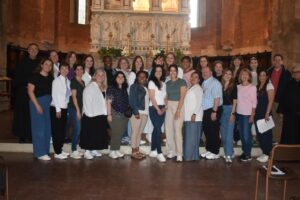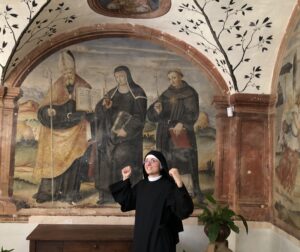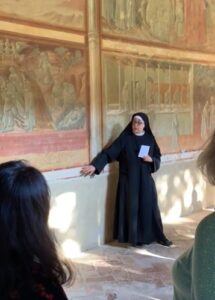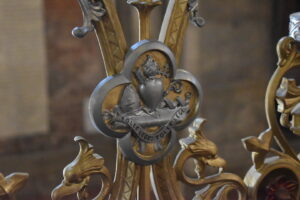This past May, I had the wonderful opportunity to participate in a pilgrimage to Augustinian sites in Italy. Villanova University’s Office for Mission and Ministry has for decades sponsored Pellegrinaggi Agostiniani, pilgrimage trips that allow members of the Villanova community to walk in the footsteps of Augustine as a way to grow in their understanding of Augustinian spirituality and heritage.
This particular trip was the first time in Villanova’s history that a Pellegrinaggio Agostiniano has specifically focused on Augustine and women: those women who were most influenced by Augustine and who had the biggest influence on him. As we visited various Augustinian sites from Milan to Ostia, our group of 28 pilgrims, most of whom were women of different ages and backgrounds, was able to reflect on Augustine’s life and legacy – but also the lives and legacies of St. Monica, St. Clare of Montefalco, and St. Rita of Cascia.

This trip was incredibly meaningful for me. Even though I have been studying Augustine for close to fifteen years, I had never been to many of these Augustinian sites before. I was inspired while praying before the ancient baptistry in Milan where Augustine became a Christian, and humbled to tears at Augustine’s tomb in Pavia. While seeing these sites on my own would still have been powerful, it was more special because I was doing it in community—particularly in a community of women.
I have always studied Augustine with women. Both my undergraduate and graduate teachers of Augustine, the late Dr. Angela Christman and Dr. Mary Keys, made Augustine’s words come alive in the classroom and embodied for me Augustine’s passion for learning and deep questioning, commitment to friendship and community, and wonder at the beauty and mystery of God’s creation. Their examples inspired me to study Augustine, and because of their influence, I never felt like an outsider doing so.
While my academic experiences of Augustine were first formed and enriched by women, Augustinian studies remains a male-dominated field, and the histories written of the Order of St. Augustine often neglect detailed discussion of the history of women. And at Villanova University, which is part of the Province of St. Thomas of Villanova, our Augustinians are all male friars. Before this trip, I had never had the opportunity to encounter anything but male Augustinian communities and therefore male Augustinian spirituality.
And so, brimming with excitement and curiosity as I prepared for this Women’s Pellegrinaggio Augustiniano and the chance to meet for the first time Augustinian contemplative sisters at Lecceto and Montefalco, the question that kept coming to mind was: What does Augustinian spirituality look like for women?

To some degree, I admit, this question is needless. Augustinian spirituality is not and does not claim to be only for men. As the late Mary T. Clark, R.S.C.J, a great Augustine scholar, has explained, “Augustinian spirituality was intended for all Christians…all are called to holiness, which does not depend merely on one’s state of life but on the level of one’s authentic love for God and neighbor” (Liturgical Ministry 2001, 198).
This shared commitment to caritas defines Augustinian spirituality for all, regardless of gender. Augustine’s monastic Rule, while it does not allow for men and women to live together, offers the same teaching in the masculine and feminine versions. Both versions of the rule emphasize that we are meant to live “in harmony” as “one mind and one heart” (Rule 1.2; quoting Acts 4:32).
While intellectually I understand the universality of Augustinian spirituality and the unity in love that Augustine offers us as the ideal of right living, my own lived experiences as a Catholic woman have demonstrated that today, as in the fifth century, women are treated differently than men; we do not have the same opportunities in leadership and decision-making, we face different and often harmful stereotypes and expectations, and our contributions and talents are frequently underappreciated, unacknowledged, or reduced to our roles as wives, mothers, daughters, and care-givers. This is not to say that such roles are unimportant—indeed, they are life-giving and on our pilgrimage we were able to have much-needed conversations about these roles, particularly motherhood, together—but I want to know more about St. Monica than the fact that she was a mother who cried endless tears for her son. I want to celebrate her as a saint in her own right, to see her as a woman I can learn from and seek to imitate, beyond her relationship with Augustine.
And so, I ask again: What does Augustinian spirituality look like for women?

When I asked this question to Sr. Sarah, one of the contemplative nuns at the Augustinian monastery at Lecceto, one of the oldest Augustinian sites, her answer surprised me. She did not, as I was expecting, talk about gender or what it was like to live in a single-sex community comprised of only women. Instead, she spoke about how her life as a contemplative differed from those of her Augustinian brothers who lead active lives.
The nuns at Lecceto rarely, if ever, leave the monastery. It is calm and peaceful there. The quiet is disrupted mostly by the wind and the singing of birds, occasionally the tolling of the bells to call the sisters to prayer. We had the chance to witness the sisters pray, which they do together seven times a day, in song. I am not sure if or when the sisters have time to practice, but their harmonies were achingly beautiful, as was their example of devotion.
Sr. Sarah assured us that though she and her sisters lead simple lives committed to prayer, they are not dull but joyous. Throughout her time with us, she smiled and laughed – and offered us gracious hospitality. She modelled an Augustinian spirituality I had never quite seen before, though it felt familiar all the same. In musical terms, it was as though a beloved melody was playing in a different key.
Sr. Sarah told us that, while her contemplative life was very different in its daily routines from her active Augustinian brothers, one is not better than the other; they are both aimed at the same loving ends.
And so, for now, this is how I am thinking about what Augustinian spirituality looks like for women. It is different in its form than what one sees in male spaces, and I am hoping to have more occasions to understand better those differences and meet more women who can teach me about how they approach and embody Augustinian spirituality.

But this diversity in approach is not a problem for Augustinian spirituality; it is a strength. The Rule calls for people to live together in harmony. Harmony cannot be achieved by playing the same note again and again. It requires differences to come together to achieve something greater than the sum of its parts. Augustinian spirituality may appear in many forms as we embody it in our own unique ways, but ultimately we are all working toward bringing about the same shared ends.
So what does Augustinian spirituality look like for women? In many ways, I am learning, it depends on the woman in question. For we each bring something of our own to make the harmony of communal living richer. And that, happily, means that there is much left to wonder about and experience.
The Women’s Pellegrinaggio Agostiniano was sponsored by Villanova University’s Office of the President, Office for Mission and Ministry, Anne Welsh McNulty Institute for Women’s Leadership, and Augustinian Institute.
Colleen Mitchell
Colleen E. Mitchell is Associate Director of Outreach for the Augustinian Institute at Villanova University, and Assistant Teaching Professor in the Augustine and Culture Seminar Program.